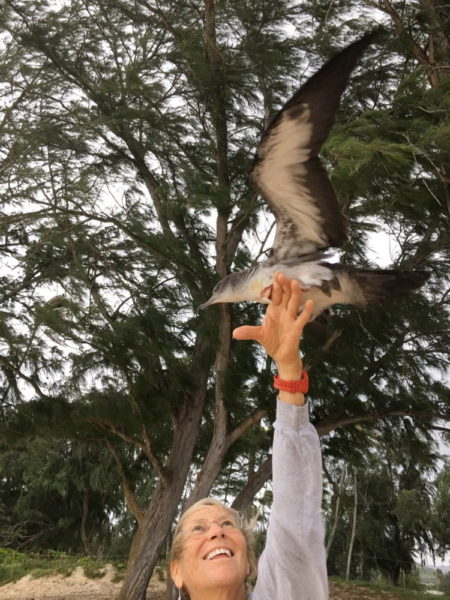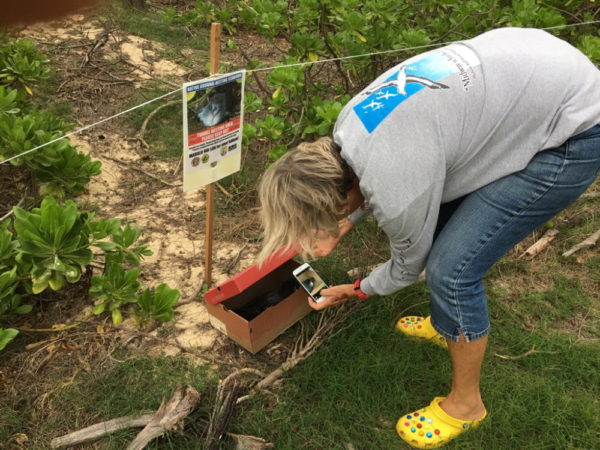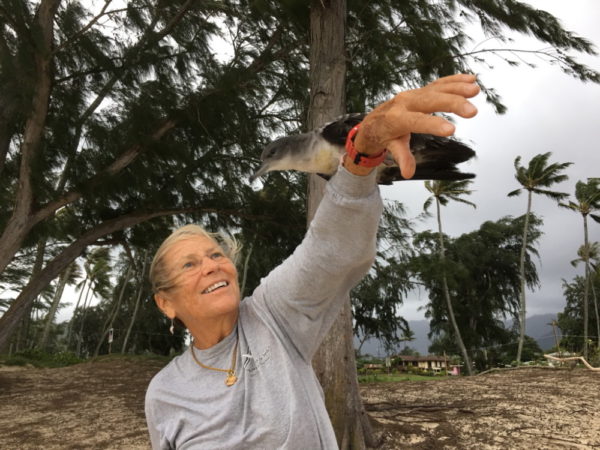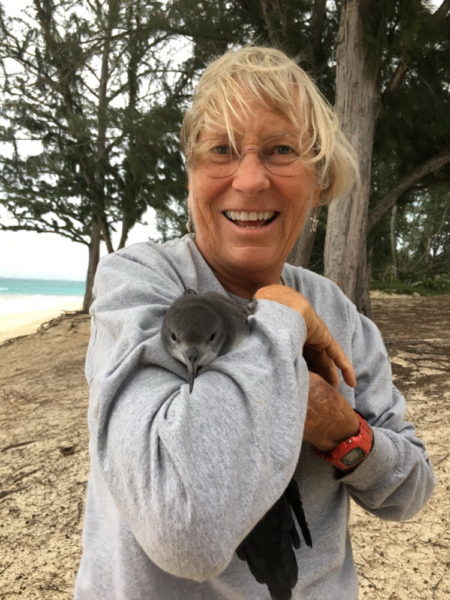Published in the Ocean Watch column, Honolulu Star-Advertiser © Susan Scott
December 2, 2017
Years ago, when I fell in love with marine biology, birds didn’t cross my mind. But as I traveled throughout Hawaii and visited other oceanic islands, I discovered that seabirds are among the most amazing of marine animals. They manage to live entirely off the ocean while not actually getting in it or, usually, even on it.
 Grounds workers found a wedgie fledgling stuck in bushes
Grounds workers found a wedgie fledgling stuck in bushes
last week, and they delivered it to columnist Susan Scott,
who helped the bird launch to sea from Kailua Beach Park.
©2017 Craig Thomas
Nor do seabirds live on land. They’re like ideal Airbnb guests, burrowing into our sandy soil (and in the case of white terns, perching in our towering trees) to lay eggs and raise chicks. Then they’re back at sea, going about their airy way.
That’s happening right now with wedge-tailed shearwaters on Oahu. Moms, dads and fledgling chicks are leaving their underground hideaways to ride the wind above the waves.
Wedge-tailed shearwaters, nicknamed wedgies by people who know them, are native to tropical and subtropical waters worldwide. The gray birds with cream-colored undersides are about 2 feet long with a wingspan of just over 3 feet.
Wedgie wings are well known among us sailors because we see the birds far offshore riding breezy air currents just inches above ridiculously boisterous waves. In shearing the water, these birds certainly earn their name.
Adult wedgies arrive on land in March to find, or reunite with, partners, singing mournful songs that sound like a human baby crying or a person groaning in pain. After mating, the couple dig a burrow or move into a vacant one, and the female lays a single white egg.
Parents take turns sitting on the egg for about seven weeks and then sit another week to keep the new hatchling warm. From then on, both male and female go to work each day to bring home the groceries, fish and squid. Adults leave the burrow at dawn, fish all day and arrive back at dusk to feed the waiting chick.
This time of year, wedgie parents are finished feeding, and their youngsters are now emerging from their cavelike homes on Oahu and its nearby islands. Some fledglings make it to the ocean on their first flights, but others get confused by lights and run into wires and poles. These feathered kids wind up on our doorsteps, sidewalks and roads.
But downed wedgies can often be saved. If you find a stunned fledgling, put it in a covered, ventilated shoe box (it grew up in a hole, so the bird is OK with this) and take it to Sea Life Park. For more rescue information, contact official wedgie helpers at Hawaii Wildlife Center or Oahu Seabird Group .
 We took the downed wedgie we found in our yard to a nearby
We took the downed wedgie we found in our yard to a nearby
wedge-tailed shearwater nesting area. I took its picture in the box.
©2017 Craig Thomas
I thank the seabirds of the world for giving my love of marine biology wings. When it comes to skimming over the ocean’s surface, seabirds are welcome companions.
 Susan Scott helping a stranded wedge tailed shearwater take flight.
Susan Scott helping a stranded wedge tailed shearwater take flight.
The bird is feeling the wind and seeing the ocean as it balanced on her arm.
©2017 Craig Thomas
 Posing for a picture.
Posing for a picture.
©2016 Craig Thomas